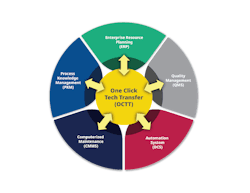The invention, rapid manufacturing and distribution of the COVID-19 vaccine demonstrates exactly how fast the life sciences treatment development pipeline can move when the right factors are in play. Biopharmaceutical treatments commonly take upwards of 15 years to develop, but the COVID vaccine was created and manufactured in only eight months.
A rare, perfect combination of financial investment and emergency authorization paved the path for the vaccine’s rapid development. Life sciences manufacturers have learned many lessons on the value of this acceleration, and it tantalizes the imagination for what could be.
Biopharma organizations are rapidly realizing that, with the right technologies and strategies, they can dramatically accelerate the drug development pipeline, improving and saving lives with new treatments.
Much of that initiative focuses on a critical strategy: shortening and streamlining technology transfer, where life sciences process specifications are transferred from early development stages to commercial production.
Today the process is largely manual. Yet the right technology, open standards and operational buy-in have the potential to reduce the technology transfer process to a fraction of the time it takes today. Stakeholders from manufacturers to automation suppliers are already putting resources into a research center and grassroots consortium to make that vision—known in the industry as one-click technology transfer (OCTT)—a reality.
For instance, Emerson has received formal commitment from the economic development board in Singapore to establish an OCTT Center of Excellence for research and development of new technologies.
Moreover, to help guide that technology development so it fits the needs of every operation, Emerson is establishing a grassroots consortium of key life sciences stakeholders from across the industry—including companies developing vaccines, oncology and infectious disease innovations, and the next generation biologics that will drive advancements in personalized medicine, and more— to steer implementation of the best standards.
Technology Transfer Today
Currently, technology transfer—the definition and transfer of life sciences process specifications from early development stages, such as research and development, to later stages, like commercial production—is largely manual. Experts in the earlier process stages in drug development provide process, materials, equipment, quality and procedural knowledge and information to those who design and implement the larger-scale manufacturing processes during later stages.
However, the processes and equipment used to make a single vial of product in a laboratory environment are very different from the large-scale production equipment, processes and automation required in a commercial manufacturing facility. To transition a product between stages, someone must translate what the people in the previous stage were doing so they can then make processes work on the next scale of equipment, usually via trial and error, potentially adding years to the development pipeline.
Much of this information transfer is still conducted via pen and paper, a variety of digital spreadsheets and documents and meetings and conversations. This extends the timeline and increases the chances of information being lost, misunderstood, improperly transferred or otherwise compromised. This can delay treatment for patients, as well as cut into patent protection and potential profits. As soon as a company receives a patent, the end date is set. If a company cannot speed its product to market, it will likely miss much of the critical patent protection period.
Vision for a Better Way
After seeing the fast development and delivery of the COVID vaccine, life sciences manufacturers are optimistic about shortening the technology transfer process, and many of the pieces to accomplish this are already in place. Life sciences companies have very mature automation systems installed at their facilities, ready to receive information and run new treatments through the manufacturing process. They also have mature enterprise resource planning (ERP) systems in place, helping them procure supplies, know where product will ship and know what sites to use for the most efficient production. Today, most companies can easily identify which sites have the capacity they need to execute at the scale they desire.
Where these companies tend to be weak in technology transfer is in digitalizing the treatment recipe from drug discovery and development all the way across the pipeline until it is manufactured at scale. This is the most important stage of the technology transfer process—if critical information is stuck in paper notebooks, the computerized systems designed to increase speed to market cannot use it.
Fortunately, companies are developing the framework for a centralized transport and translation platform. New tools—for example, process and knowledge management software—are closing the gap to speed technology transfer. These holistic software packages electronically capture every decision made in the treatment development process. Not only is information more standardized and reliable, but process parameters and calculations are automatically managed, facilitating easier scale-up in every stage of development.
Next Steps
The most difficult step comes in building a framework to effectively use transport and translation platforms to unite the many disparate systems (ERP, process and knowledge management, maintenance management systems, quality management, automation systems, etc.) into a cohesive whole (Figure 1).
Figure 1: Life Sciences companies today spend inordinate amounts of time and money to move information (recipes, process steps, parameters, equipment characteristics, quality requirements, etc.) between their various “single source of truth” databases. Credit: Emerson
But industry leaders are ready to meet that challenge, building a vision to unify all these systems and unlock one-click technology transfer.
Tying systems together to accomplish OCTT will require open standards, a common goal of what the solutions will accomplish, and defining how the many players across the industry will work together. Much as in life sciences initiatives of the past, consortium and standards bodies will play an important role in creating such a paradigm shift.
Real-World Impact
The world has seen what is possible with expedited treatment manufacturing. Such a change would dramatically improve the lives of patients around the world, especially considering the many new treatment technologies emerging in the marketplace. The tools and technologies to accomplish a step change in the life sciences exist. Now, the key players simply need to get in the game.
Nathan Pettus was named president of Emerson’s Process Systems and Solutions business in June 2021. He oversees a business that helps some of the world’s leading companies in a wide variety of industries leverage automation software and technologies to optimize operations, protect personnel and reach sustainability targets.
****To comment on this article, please scroll down past story recommendations to "Voice Your Opinion."




